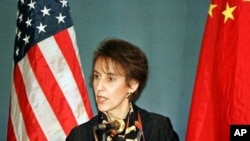The rapid growth of China's economy over the past few decades has created new market strengths in Asia as Western countries have struggled to cope with recent economic pressures.
Ambassador Charlene Barshefsky served as U.S. Trade Representative from 1997 to 2001 in the Clinton Administration. Speaking recently at the Center for Strategic and International Studies in Washington, she outlined four trends in global trade with respect to China.
The first trend she spoke about is the acceleration of globalization. The second is the reemergence of China and the integration of Asia around China as its hub. Third, she mentioned China's reemergence comes at a time of extraordinary economic weakness in the West. She said the fourth broad trend is the new competitive environment accelerating the disruption of settled industries.
Ambassador Barshefsky said the trends are historic. "The global economy is larger, it is growing faster, it is more integrated economically under the pressures of technology and capital flows than ever before in any historic sense," she said.
She said the second broad trend, the reemergence of China, should not come as a surprise. "I always use the word 'reemergence' with respect to China because 160 years ago the global economy was dominated by two countries, China and India, and China held over 30 percent of the world's GDP. By comparison, today we hold 18, 19 percent of the world's GDP, maybe. They were over 30 percent. So, the reemergence of China. This has created a structural shift in the global economy. It is 'the' international economic story of our lifetimes," she said.
China has enjoyed robust growth rates over the past 30 years. China's economy is now larger than Japan's or Germany's, but still smaller than the U.S. economy.
Ambassador Clayton Yeutter, who served as the U.S. Trade Representative from 1985 to 1989 in the Reagan administration, said the current Trans-Pacific Partnership agreement is an opportunity for the United States to tap into Asia's growth.
"This is certainly the most active trade agreement, active trade negotiation we have in the world today. And it may well represent the wave of the future. One could certainly hypothesize that plurilateral agreements might well be the wave of the future in contrast to bilateral agreements or multilateral agreements that take a decade or more to negotiate," he said.
Ambassador Barshefsky said the United States has to understand China and the Asia region is in an economic pattern that has not been seen in our lifetime, but has historical precedent.
"[China] has integrated with its Asian neighbors. Far less important than trade agreements between them is the fact that these economies have reverted to a more historic pattern in Asia, a pattern with which we are unfamiliar, but a pattern with which we would have been familiar had we lived 200 years ago or 1,000 years ago, 2,000, 4,000 years ago. So this is a very different era, a very different situation," she said.
Part of the difference is a climate that includes technologically advanced communications and financial systems for facilitating transactions. Combined with the improved transportation of products, nations have to agree on regulations, which Ambassador Yeutter said is a major part of negotiations on the Trans-Pacific Partnership agreement.
"There is a lot of good work being done on trade facilitation. There is work on some regulatory coherence, which is badly needed particularly in the sanitary, phytosanitary area, and some really good work, advanced work on intellectual property, and then more work on investment than has traditionally gone into trade agreements," he said.
Multinational corporations have increased tenfold in 35 years to more than 75,000 in operation today. But the economic downturn has led to a reduction in global trade.
In her third point on the broad trends, Ambassador Barshefsky said the reemergence of China has come at a time when trade levels are close to those last seen during the Great Depression of the 1930s.
"This is a very volatile combination. [There are] extraordinary global imbalances which we have all read about: trade imbalances, financial imbalances, trade deficit countries versus trade-surplus countries, currency issues, competitive non-appreciation of currencies, and all the rest," she said.
The fourth broad trend is the weakening of Western economies, which has led to job losses in many areas. U.S. manufacturing has been eroding for over 40 years. An increase in technology-assisted productivity has led to the need for fewer workers to create the same output, resulting in job dislocation.
Ambassador Barshefsky says President Barack Obama is pushing for increased trade exports and improved education in research and development to help offset the losses.
"The administration has been spurred to drive - begin to drive a competitiveness agenda, and this is absolutely critical. If our house is not in order, I do not care what we do on the trade side. We are lost. We have to get our house in order. There is no excuse for us not to put into place policies which are solely in our control to do to enhance U.S. competitiveness," she said.
Ambassador Yeutter said the Trans-Pacific Partnership agreement could assist U.S. efforts if other nations can be brought into the pact. "The hope is that if this agreement is done really, really well, that it will then have bolt-on possibilities as what I call "bolting on additional countries" at a later time with a relatively short negotiation being needed because of the quality of the agreement that is presented to them," he said.
Ambassador Yeutter said the Trans-Pacific Partnership agreement could be ready in time for the APEC meetings this year, hosted by the United States in Honolulu in November.
Former US Trade Reps See Opportunities, Difficulties in Chinese Economic Growth












